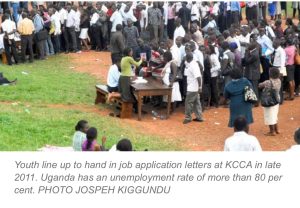By Denis Jjuuko
Uganda’s healthcare has been in the spotlight after tweeps (people on Twitter) decided to do an exhibition of it — basically highlighting the challenges in our public health facilities. Some of the images and experiences are heart wrenching! Equipment rotting away, patients on the floor, caretakers working in gardens to pay nurses.
If you have been to public health facilities (even some private ones), you have probably experienced some sort of trauma after seeing what people go through. Even though the government has tried in some areas such as building some new hospitals, equipping others and all that, there is no doubt that our healthcare is in need of critical care.
Uganda aspires to become a middle-income country (and claimed at one stage that it had) but it can only get there if its population is healthy. A healthy population is a harbinger for economic prosperity.
The majority of Ugandans are under the age of 35, which means that for the foreseeable future, this is the population segment that will constitute the country’s labour force. It is a matter of time before they start dominating the politics.
But there is no country that can improve its healthcare systems unless there is some form of personal responsibility for the people themselves. If you are a regular visitor to Uganda’s public health facilities, you will notice that the majority of patients shouldn’t be there in the first place.
Take for example the maternity sections of public health facilities. In many of them, you find teenage girls either giving birth or suffering from effects of abortion or have given birth to babies prematurely. They should never be in maternity wards in the first place. They should be in school. Some years ago, on a trip to Kasese, I met a 30-year-old grandmother. Her 14-year-old daughter had just given birth. If this family cycle continues, she is on course on being a great grandmother at age 45. And she was still planning to give birth to a few more babies herself.
If it is not teenagers giving birth or undergoing effects of abortion, it is women like that Kasese grandmother giving birth with reckless abandon. They are in their 30s (although they look like 50-year-olds) with six children and “planning for two more.” They are putting their health at risk and they are crowding public health facilities. Why would a poor woman want eight children today? They can’t look after the six they have and are “planning for two more.”
They don’t have mosquito nets so they end up with malaria. When they have mosquito nets, their homes harbour the mosquitos. No government is going to slash your compound or drain it of stagnant water. No government is going to pick you from your home so that you go for antenatal care (ANC) at least six times during your pregnancy. There are village health teams but they can only advise. And due to failure to attend routine ANC sessions, some women end up with conditions such as eclampsia that could have been better managed.
If it isn’t the maternity ward, people are in hospitals because of delays to get professional advice. In urban areas like Kampala, there is a pharmacy every few meter’s. We end up diagnosing ourselves and treating ourselves by buying drugs over the counter. By the time we access health facilities, sometimes it is already too late. Should pharmacies sell drugs without prescription? In proper countries, you can’t get drugs over the counter without a prescription. That is for government to enforce but we know our government, as individuals, we have to take some personal responsibility.
Today, when you go to primary schools where the elite take their children, you will see kids who are already obese. Because we grow up in villages in poverty, we think that a child consuming sugary carbonated drinks every day is a sign of love.
Many parents once they pick the kids from school, they stop by fast foods restaurant so Junior can get some “finger licking sizzling” chicken, chips and burgers. Already the kids aren’t doing any physical exercises. These kids will end up in health facilities when they shouldn’t be there.
While at an event, once you go to the toilet, just observe how many people wash their hands and you will be shocked. And then they offer a handshake or a hug to everyone at the event, thereby spreading disease.
As adults, how many of us sleep for at least eight hours a day? How often do we get vitamin D from the sun? How often do we do physical exercises, eat healthy and do everything that would stop us from being sick?
Kampala bars are full of shisha — some form of piped smoking consumed by sometimes highly educated pregnant women while their men are cheering and ordering for more. They know how bad our hospitals are and they know they are ending up there but what do they do? They consume more shisha and drink excessive alcohol.
This isn’t to absolve the government from its ineptness but as individuals we too have some responsibilities.
The writer is a communication and visibility consultant. djjuuko@gmail.com











